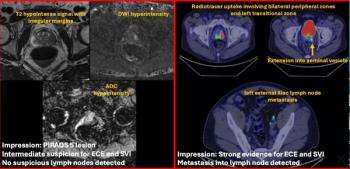
GE completes acquisition of Applicare Medical Imaging
GE completes acquisition of Applicare Medical ImagingDeal adds teleradiology, miniPACS support to PathSpeedConsolidation continues in the PACS market as vendors strive to find the right product mix and strategic reach to achieve market
GE completes acquisition of Applicare Medical Imaging
Deal adds teleradiology, miniPACS support to PathSpeed
Consolidation continues in the PACS market as vendors strive to find the right product mix and strategic reach to achieve market dominance. GE Medical Systems quest for worldwide market leadership in PACS received a nice boost with its acquisition of Dutch PACS software developer Applicare Medical Imaging for undisclosed terms in late May (PNN 6/99).
GE decided to acquire Applicare for a number of reasons, including the opportunity to broaden its PathSpeed PACS product line to include support for teleradiology and small-scale or entry-level miniPACS implementations, said Vishal Wanchoo, general manager of GEs Mt. Prospect, IL-based Integration Imaging Solutions division.
With PathSpeed, were really hitting the mid-range to enterprise PACS sectors, he said. Now customers could start with a small-scale system and expand it up from there.
This new capability will help GE to expand its presence in the European and Asian markets, where healthcare institutions are targeting smaller-scale entry points into digital image management.
In addition, GE was interested in a number of Applicares other technologies, including a QC workstation developed by the Zeist, Netherlands-based firm. The workstation has been deployed as part of Applicares participation on IBMs PowerPACS team involved in the U.S. militarys Digital Imaging Network-Picture Archiving and Communications Systems (DIN-PACS) project.
GE was also interested in Applicares work-in-progress, low-cost, Windows NT-based software-only archive product, which is scheduled for release in September. In addition, Applicares RadWorks WebViewer Web-based image and report distribution offering will comple- ment GEs own Unix-based Web-Link product.
Web-Link is a Sun-based product that is integrated into PathSpeed, while Applicare basically has a stand-alone, NT-based DICOM Web server, Wanchoo said. These products address totally different segments of the market.
As a result of the Applicare deal, GEs relationship with Lexington, MA-based Access Radiology for teleradiology software in the U.S. will be discontinued in favor of RadWorks, Wanchoo said. Applicares management and software development efforts will remain intact, with Applicare CEO Ruud Kroon reporting directly to Wanchoo. Both GEs and Applicares product development efforts will be continued, and Applicares R&D team will be expanded by over 50% by the end of this year, Wanchoo said. GE plans to begin marketing Applicare technology within 60 to 90 days.
Applicare markets its RadWorks software through distributors and through OEMs such as Picker International and Kodaks Cemax-Icon division. The company will maintain those relationships, said Kroon.
Our multichannel strategy is extremely valuable for us not just in terms of money, but also in terms of market feedback, Kroon said. We have companies like Kodak, Picker, British Telecom, and about 20 independent distributors. They all have a different angle in the marketplace, and they provide different feedback for product improvements.
Applicare will retain its name and will maintain its own booth at the RSNA meeting in order to emphasize its commitment to its channel partners, Kroon said. Indeed, the company has been aggressively expanding its already sizeable roster of OEM clients lately, adding ADAC Laboratories, Konica Medical Imaging, and Merge Technologies in recent months (PNN 6/99).
For Applicares part, the privately held company decided to pursue an acquisition due to its owners belief that the PACS market will consolidate in the long term into a small number of companies, likely large multinational firms, Kroon said. Rather than wait for consolidation to be forced on them, the Applicare investors in late 1998 decided to proactively pursue an acquisition. A controlled auction was held, and while GE was not on the early list of companies vying for Applicare, it emerged late with a bid that was attractive in the dollar amount, as well as a strategic fit between the two companies, Kroon said. In an interesting twist, sources close to the situation say that DIN-PACS team leader IBM played a key role in bringing the companies together.
The deal marks the beginning of a new era for Applicare, a small company that has had a strong impact in the PACS market, particularly in the second half of this decade. Founded in 1987 by CEO Ruud Kroon, Applicare was one of the first to release NT-based PACS software, the first of which was a teleradiology offering completed in the summer of 1994. But the companys big break was its inclusion in 1996 on the U.S. militarys DIN-PACS project team. At the time, many industry observers believed that the companys highly regarded NT-based software played a big role in the award to IBM. Applicares DIN-PACS contributions will be continued, Wanchoo said.
With the Applicare deal, GEs IIS organization can now draw on the software development and systems integration resources of several GE companies around the world, including the firms Innomed RIS company in Dornstadt, Germany, Wipro GE Medical Systems in India, and at GE Yokogawa in Japan.
Clearly we want to provide a global solution, but in this market you have to have a lot of local activity, especially regarding systems integration initiatives and (product) customization, he said.
The deal is a great move for GE, especially as it seeks to expand its European presence, said Michael Cannavo, president of Image Management Consultants of Winter Springs, FL.
What remains to be seen, however, is whether the market will choose to buy Applicare products from current partners such as Picker and independents such as Meta Solutions, or go directly through GE, he said.
Search again Homepage
Newsletter
Stay at the forefront of radiology with the Diagnostic Imaging newsletter, delivering the latest news, clinical insights, and imaging advancements for today’s radiologists.




























